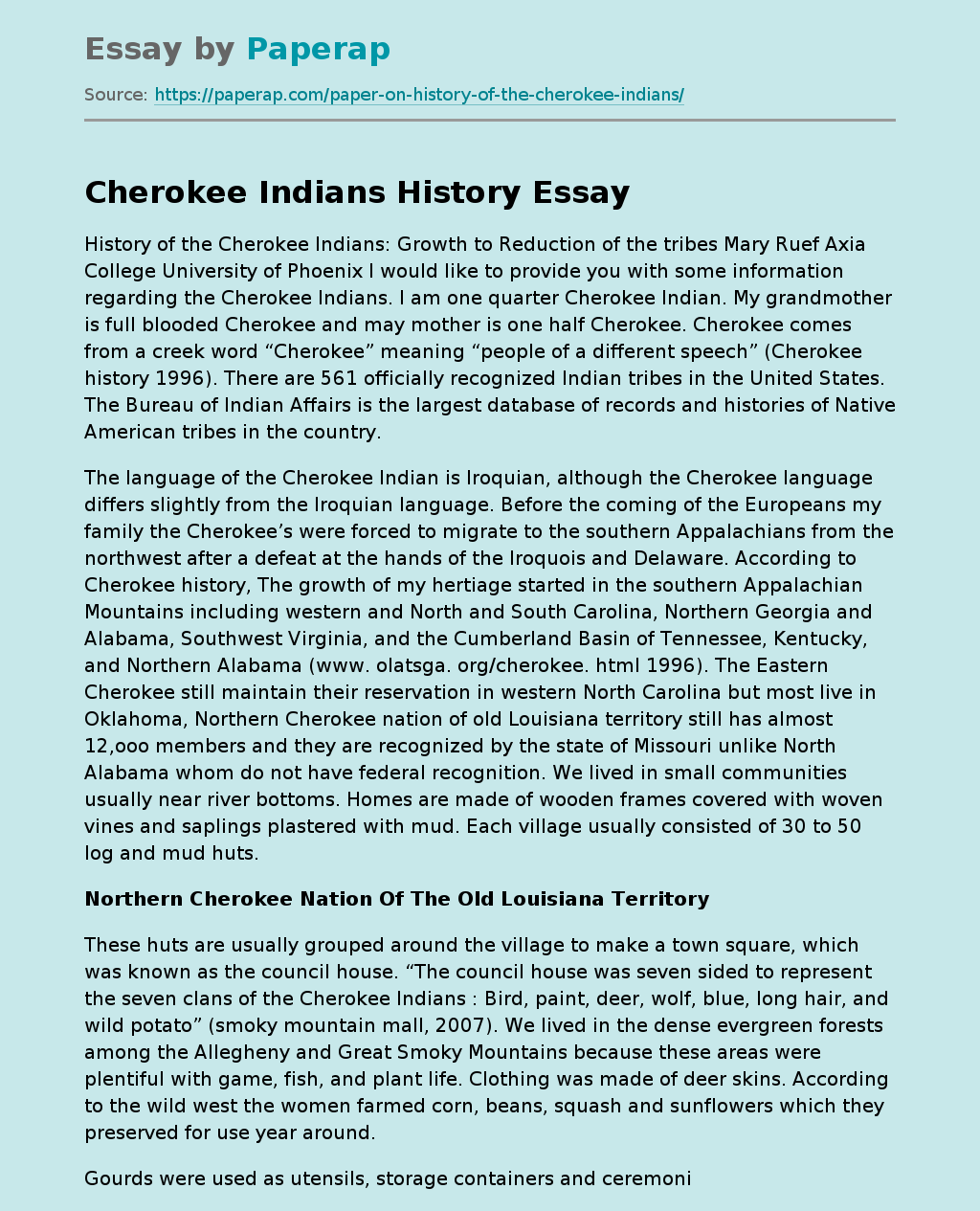Cherokee Indians History
The language of the Cherokee Indian is Iroquian, although the Cherokee language differs slightly from the Iroquian language. Before the coming of the Europeans my family the Cherokee’s were forced to migrate to the southern Appalachians from the northwest after a defeat at the hands of the Iroquois and Delaware. According to Cherokee history, The growth of my hertiage started in the southern Appalachian Mountains including western and North and South Carolina, Northern Georgia and Alabama, Southwest Virginia, and the Cumberland Basin of Tennessee, Kentucky, and Northern Alabama (www.
olatsga. org/cherokee. html 1996). The Eastern Cherokee still maintain their reservation in western North Carolina but most live in Oklahoma, Northern Cherokee nation of old Louisiana territory still has almost 12,ooo members and they are recognized by the state of Missouri unlike North Alabama whom do not have federal recognition. We lived in small communities usually near river bottoms. Homes are made of wooden frames covered with woven vines and saplings plastered with mud.
Each village usually consisted of 30 to 50 log and mud huts.
Northern Cherokee Nation Of The Old Louisiana Territory
These huts are usually grouped around the village to make a town square, which was known as the council house. “The council house was seven sided to represent the seven clans of the Cherokee Indians : Bird, paint, deer, wolf, blue, long hair, and wild potato” (smoky mountain mall, 2007). We lived in the dense evergreen forests among the Allegheny and Great Smoky Mountains because these areas were plentiful with game, fish, and plant life.
Clothing was made of deer skins. According to the wild west the women farmed corn, beans, squash and sunflowers which they preserved for use year around.
Gourds were used as utensils, storage containers and ceremonial rattles. “Our spiritual belief revolves around a Creator and spirits who embody the sun, moon, and stars. Harvest ceremony is very important to any agricultural tribe” (www. thewildwest. org 2008). A dance known as the Green Corn Dance is held each August to hedge our bet for a good harvest. My native American culture live and love with nature. We created harmony within our environment in what we wear, create, what we eat and how it we prepare it. Our home life is important as well as our beliefs and philosophies.
Even though Indian heritage is rich in tradition and culture, many Indians that live on reservations are struggling with a different legacy. According to the American Indian Tragedy more than 300,000 Native Americans are either homeless or living in life threatening conditions. “American Indians are faced with suicide rate double that of all other nonwhites, and higher levels of school dropouts, alcoholism, and unemployment” (American Indian Tragedy 2008). Many housing for the Indian reservations do not have electricity or running water due to these areas being so isolated.
Many of our Indian reservations lack high quality natural resources. Agricultural productivity on Indian lands is less than on similar private lands. Income for us consist of casinos however these casinos are not created equal. Some of the casinos that are tribally owned are economic failures. Some of these casinos are profitable and create millions of dollars or more in profits. According to the American Indian Tragedy the high rate of poverty on many Indian reservations stems from a historical amalgam of federal policies which were intended to push Indians to become civilized.
A lot has changed in the Cherokee nation it now has become a leader in housing, education, vocational training, economic development and business. According to the federal government the Cherokee nation has the right to exercise control over their tribal assets. Our assets not only include the 96 miles of the Arkansas River bed but also include 66,000 acres of land. February 10, 1990 a tax code was approved by the Cherokee nation to include sales tax and tobacco tax on all services and goods sold in the Cherokee Indian tribal land. The main purpose of this tax code is to increase the revenue so that they can provide the Cherokee Indians with a better way of life (Cherokee Nation 2008).
Cherokee Indians History. (2019, Dec 05). Retrieved from https://paperap.com/paper-on-history-of-the-cherokee-indians/

